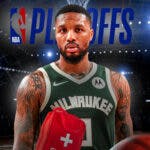The Chauncey Billups era in Rip City didn't exactly live up to its promise during his team's preseason debut. Gashed on defense from the opening tip and far too careless with the ball offensively, the Portland Trail Blazers fell 121-107 to the Golden State Warriors on Monday night at Moda Center.
Portland coughed up 26 turnovers. The Warriors hoised a whopping 69 threes, the second-most of all time in an NBA game, hardly a ringing endorsement of the Blazers' new defensive scheme. Cody Zeller left with a broken nose. Jordan Poole dropped 30 points in 22 minutes. Norman Powell was forced to sit early, too, sidelined by a hip injury.
Needless to say, not everything went right for Portland on Monday. But preseason is preseason, and it's always worth remembering that despite their core remaining intact, the Blazers still remade their rotation this offseason. It's never easy for any veteran team to significantly alter its approach on one side of the ball, let alone two. Portland was bound for an adjustment period, basically.
An even brighter silver lining? The Blazers and Warriors were tied 60-60 at halftime, prior to Damian Lillard and C.J. McCollum taking the rest of the night off. Positives aren't as hard to find in Portland's play as the box score indicates. Here are three more from the Blazers' exhibition opener for 2021-22.
Dramatically Improved Bench Defense
There was a notable difference in Portland's defensive execution once Billups went to the bench. What that says about Jusuf Nurkic's fit in the Blazers' new defensive scheme remains to be seen, but what's abundantly clear is this game changed in the first half once Cody Zeller and Larry Nance Jr. got on the floor. Hyper active and constantly communicating, they looked much more comfortable showing and recovering on ball screens and navigating backside help than Portland's starting frontcourt. The load of three-point attempts Golden State got up against the bench were of objectively lesser quality, and the Blazers' reserves also did a better job preventing back-cuts than the starters.
None of that should necessarily be surprising. Zeller and Nance each played in defensive systems last season that at least somewhat resembled the one Billups is implementing with the Blazers. Nurkic was the linchpin of Terry Stotts' ultra-conservative defense for years, while Robert Covington was with the all-switch Houston Rockets—and before that the hapless Minnesota Timberwolves—before being traded to Portland in advance of last season. Zeller and Nance, frankly, are just quicker than the Blazers' starting frontcourt individually and collectively, too.
These tandems don't need to be compared directly all season long. Nurkic will play plenty with Nance throughout 2021-22, and it wouldn't be surprising if Zeller's playing time dwindles as Portland's team-wide defensive execution improves and Billups gets tempted further into embracing small-ball. Zeller and Nance also had the benefit of playing with Nassir Little, superior to Norman Powell as a helper.
The Blazers just couldn't move with this sense of urgency—enough that Nance and Little both sprint to the corner, confident leaving a blah shooter like Andre Iguodala from the wing—under Stotts.
The real takeaway for now? What a massive improvement the Blazers' interior bench defense is compared to last season. It's not exactly shocking considering the bullseyes Carmelo Anthony and Enes Kanter represented every time they stepped on the floor. Any concerns Billups has about Portland's incumbents adjusting to his system, though, are no doubt eased by the presence of reliable defensive stalwarts like Nance and Zeller.
An Embrace of Billups' Offensive Principals
There were definitely times when Portland settled for simple high ball screens or perimeter isolations on Monday night. Ask Stotts how easy that is to do with Lillard and McCollum at the Blazers' disposal; they dominated separate stints of the first half on offense in perfectly typical fashion. But Billups' justification for changing basketball's second-best offense was never about taking the ball out of his best players' hands, and Portland proved it in the exhibition debut.
The Blazers assisted on 15 of their 21 baskets in the first half before Lillard and McCollum's nights were finished, subsisting largely on the principals Billups has been preaching. Portland pinged the ball from side to side in the halfcourt, took advantage when the Warriors' defensive pressure created passing lanes for backdoor layups and consistently sought out early offense by pushing the ball up the floor regardless of make or miss on the other end. Nurkic went 2-of-4 from three, too, launching with confidence when Golden State left him alone at the arc in ball-screen action.
This type of random attack in secondary transition is exactly what Billups wants, even when initiated by a non-ball handler like Covington.
Turnovers were obviously a huge issue for the Blazers on Monday, a would-be red flag for a team that's long boasted one of the league's lowest turnover rates. One more reminder: This is the preseason. Billups is surely encouraging his team to embrace its new offensive tenets even at the expense of ball security, fully confident Portland will commit fewer turnovers when the games start to matter and they've had more time operating in his system than five days of practice.
The Blazers looked like a different team offensively against the Warriors, but still one that should rank among the league's true elite—probably the most encouraging overall takeaway from Billups' first time on the sidelines.
Anfernee Simons, Point Guard
Among the biggest stories from Portland's first few days of training camp was the coaching staff intentionally shouldering Anfernee Simons with playmaking responsibilities. He indeed split ball-handling duties with McCollum when they played without Lillard, as planned by Billups. But former's individual scoring burst early in the second quarter came with Simons, who flashed traditional point guard skills all night long, playing setup man.
Simons finished with six assists, a team-high, and didn't commit a single turnover. None of his dimes were necessarily of the value-add variety; Simons' best instincts are still as a shooter. But even last season, when his clear overall progress could've been easily overlooked, Simons didn't regularly make routine passes like this lob to a sealing Zeller when the opportunity presented itself.
It's not hard to forget Simons, now in his fourth season, is still just 22. His developmental timeline was always longer than other draft prospects' when the Blazers drafted him in 2018. Maybe his clear development as a ball handler is an indication of that inevitable growth more than anything else. Given the efforts of Portland's new staff to empower him, though, it sure seems like coaching is paying off for Simons like it never has, too.
The next step for Simons? Further exploring his newfound freedom with the ball by regularly attacking the teeth of the defense.




